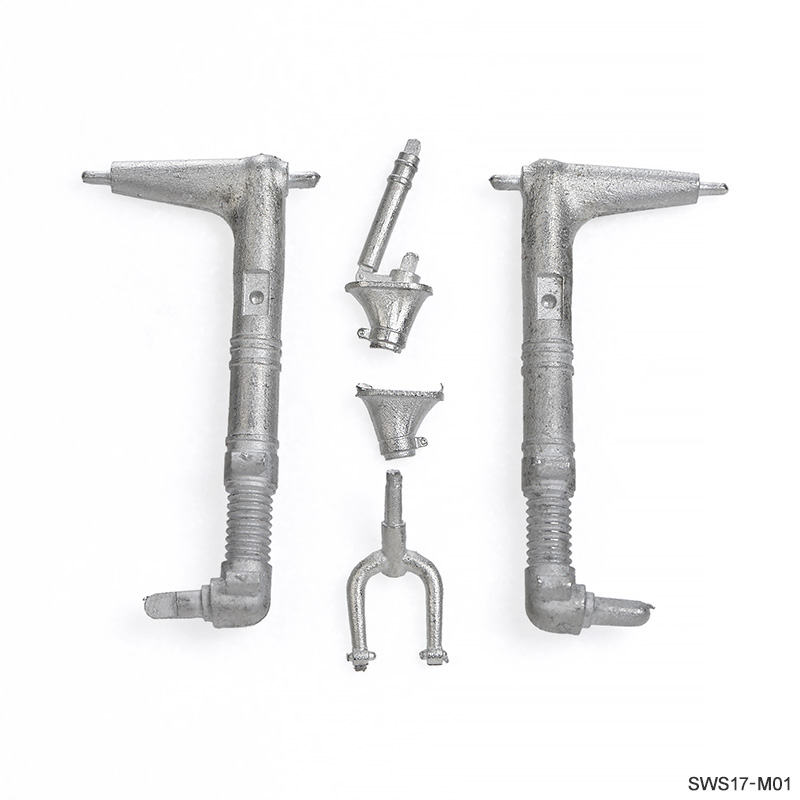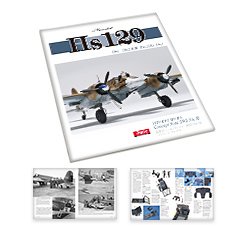Description
The Henschel "Hs 129" is a tank buster that was equipped with powerful ground-attack weapons and destroyed the influx of Soviet tanks during World War II.
Scale: 1/32 scale
Product Type: Two-color molded (gray, clear) Injection plastic kit
Sculpted by ZOUKEI-MURA
Size: Overall height about 93mm, overall width about 443mm
Total length about 344mm
Total Parts: 443
Includes: Decal ×1
The three major points of Hs 129 B-3
1) The true essence of "Tank Buster" revealed by SWS. The Henschel Hs 129 was mounted with powerful ground-attack weapons to destroy Soviet tanks in the Second World War. Designed specifically for ground attacks and known to be easy to service, the Hs 129 earned a high level of trust from its pilots. This kit brings you all the details of the structure and it function in a way that only heavily-researched SWS kits can.
2) Developed to be a heavily-armed ground-attack aircraft Hs 129 and its final evolution B-3’s standard armament consisted of two MG 17/7.92mm machine guns mounted in the wing roots and one BK 7,5/75mm anti-tank gun beneath the fuselage. Although the MG 17 on the wing is not mounted on the aircraft with the markings used in this kit, we replicated the BK 7.5 mounted on this aircraft employs a large drum magazine that holds 12 75mm shells and is automatically loaded by electromagnetic pneumatic control.
3) The Hs 129 was designed to be a compactly-sized ground-attack aircraft. In particular, the B and later versions had a trapezoidal fuselage with straight wings, a textbook example of simplistic, sturdy design. With its closely-situated engine nacelles and cowlings, once can truly appreciate its functional beauty as a small twin-engine aircraft. This SWS kit pushes the limits to thoroughly replicate that functional beauty as a “miniature version of the real aircraft.”
EXPLANATION OF EACH PART
COCKPIT: Discover the rigid fortress-like cockpit that protected pilots from the intense ground-based anti-aircraft attacks.
The Hs 129’s trapezoidal cockpit was extremely cramped due to its narrow frame. The instrument panel was reduced to only the most vital elements and the gun sight was mounted on the top of the nose outside of the cockpit. Some of the instruments were mounted to the inboard faces of the engine nacelles, like other German aircraft including the Bf 110 and Ju 88. The cockpit was encased in a sturdy fortress-like armored “bathtub” to protect the pilot from ground-based anti-aircraft gunning. The windscreen was made from multi-layer 72 mm-thick bullet-proof glass and the top 2/3 of the window was retractable to improve the ease of entering the cockpit. However, this essentially eliminated any rear visibility and greatly reduced the front visibility. The SWS kit replicates the subtle differences for the different armament versions, in additional to the shared instruments.
ENGINE: The Hs 129’s engines reveal the true value of SWS kits; learning about the development concept and historical background as you build.
The Hs 129 was originally powered by the Argus As 410 engines, which had insufficient power. However, after Gnôme-Rhône 14M engine production in occupied France became a possibility, it was quickly decided that the Hs 129 was to be powered by those engines instead. The 14M engines still had insufficient power, but they were both more compact and performed better than the As 410 A engines. The variable-pitch Ratier 1527/1528 propellers were also produced in occupied France. Making use of the equipment that once belonged to an enemy country after occupation is a logical strategy that was made possible by the land connection of the European region. These propellers were also selected because while the German twin-engine aircraft engines rotated in the same direction together, French engines rotated in opposite directions for the left and right sides, so they were not interchangeable. Therefore, the aircraft used similarly French-made left-rotating and right-rotating propellers for each engine, respectively. This SWS kit brings you the full picture so that you can truly experience the development concept and historical background as you build.
WEAPONS: This is the ultimate "tank buster"! The heavy armament of the "B-3", its final evolutionary form, has been fully replicated.
The fixed armament of the "Hs 129" usually consisted of two MG 17/7.92mm machine guns at the wing root and two MG 151/20mm machine guns on the sides of the fuselage, up to 300kg of explosives mounted on the wings and beneath the fuselage, and various other armament options were planned to mount beneath the fuselage. The "B-3," which evolved as the ultimate "tank buster" had one BK 7.5/75mm anti-tank gun for aircraft mounted as a fixed armament beneath the fuselage, and the MG 151 on the side of the fuselage was not mounted to accommodate the huge drum magazine of the BK 7.5 inside the fuselage. The BK 7.5 mounted on this aircraft employs a large drum magazine that holds 12 75mm shells and is automatically loaded by electromagnetic pneumatic control. Weighing 700 kg, this huge cannon made the aircraft slow and heavy, but its power was said to be tremendous. It is also interesting to imagine its heroic performance in defeating the IS-2 tanks with a single blow.
MAIN WING: SWS faithfully replicates the sturdy wings and landing gear that could withstand many low-altitude ground attacks with heavy weapons.
The Hs 129 wings were designed to be thick and strong, with a straight leading edge and a tapered trailing edge on the wing planform. The wing’s construction was divided between the inner wing up to the outside edge of the engine nacelles and the outer wing extending beyond. The inner wings stored one 205-liter fuel tank on the inner side of each wing, and the wing’s inboard armament was mounted near to the fuselage. Bombs could also be mounted underneath the outer wings. The main struts were hydraulically pulled back into the nacelles behind the engines. The structure supporting the axis of the main wheels was designed to also support the engine rack in the front. The tail wheel was not retractable, and it was left exposed during flight. This SWS kit faithfully replicates the dimensionality and density of the simple area around the landing gear, not missing any details to fully recreate the rugged yet beautiful wings. The parts were also carefully designed for ease of assembly.
HENSCHEL HS 129 EXTRA PARTS:

SWS19-M01
Hs 129 B-3 Turned Metal Machine Gun and Pitot Tube Set
- Type: Turned Metal Parts
- Included Items:
BK 7.5/75mm anti-tank gun ×1, 75mm Ammunition ×12, Pitot Tube ×1

SWS17-M02
Hs 129 Weighted Tires
- Type: Resin Parts
- Included Items:
Main Tire ×2,
Rear Tire ×1

SWS17-M01
Hs 129 Metal Struts
- Type: Metal Parts
- Included Items:
Main Landing Gear ×2,
Rear Landing Gear ×1

Zoukei-mura CONCEPT NOTE
SWS No.Ⅺ Henshel Hs 129
- 64 Pages, All Color
- Language: Japanese & English









